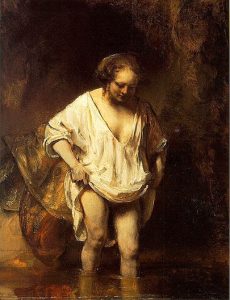Alice White, who is an oil painter and Art tutor at the University of the Arts and UCL in London, gave a stimulating talk on how artists as “makers of art” have broken the boundaries of the way paintings have been made throughout history and how medieval art effectively paved the way for the modern art that we see today.
as “makers of art” have broken the boundaries of the way paintings have been made throughout history and how medieval art effectively paved the way for the modern art that we see today.
Both Rembrandt and Turner were innovators, hands on masters of their art devising ways of adopting and adapting new technologies and substances in their work. Rembrandt (1606-1669) mixed oils, glazes, glass and chalk into his paint to create the right effect. He would prime and paint his wooden boards with a brown umber that he found enhanced both depth and colour to his paintings. In “A Woman Bathing in the Stream” (1654) he mixed crushed charcoal with white lead paint to show the subtle shades in the woman’s garment.
J.M.W Turner (1775-1851) was an alchemist in his use and mix of watercolours, beeswax, ink and chalk in his paintings. He liked to paint outside where he would work quickly and capture the light. His sketchbooks are filled with his experimentations of every kind. He would even use the texture of the rag made paper he painted on by scoring it with his sharp thumb nail to roughen the look of the paint.
Alice developed her theme of artists as a “makers and doers” of the artistic process further, describing how Jackson Pollock (1912-1956) broke the traditional rules of painting by working on the floor and pouring, flicking, dripping, and splattering his paint from pots to get the abstract expressionist effect he wanted, since he believed that the process of painting was as important as the final piece of work itself.
Alice finished her talk with examples of Lucio Fontana’s work (1899-1968) who believed that art should be a reflection of our time and not perpetuate the artistic traditions of the past – which instigated some interesting questions and discussion at the end.
Liz Beecheno
